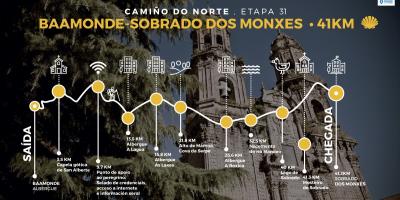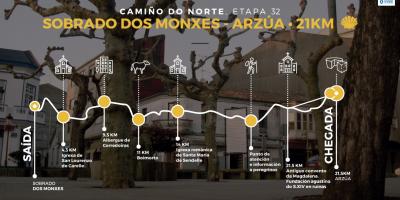The Northern Way is a route of great historical significance, as it certainly was among the first to emerge after the discovery of the tomb of St. James, generating some confusion today with the Primitive Way. In its early years, this road located to the north as its name suggests, was given its full meaning given the expansion of Al-Andalus, which limited the possibilities of routes further south.
The Asturian and the rest of the north of the peninsula pilgrims gave rise to their own route, the Northen Way. This route, which runs through the lands of the Basque Country, Cantabria and Asturias, enters Galicia through Ribadeo.
The road in the province
In the province of A Coruña, the Northern Way runs through the municipalities of Desván, Boimorto, Arzúa, or Pino and Santiago de Compostela. In the first of tje municipalities there is a building that especially stands out: the Monastery of Sobrado dos Monxes, whose activity returned in the mid-twentieth century, quite apart from being properly restored, is a obligatory stop for anyone who sets foot on this lands. After passing Boimorto, place of pazos and beautiful worth visiting balconies, in the municipality of Arzúa is where this route is joins with the frequented French Way. We must also remember that this area that runs along the Northen Way in the province is well known in gastronomy, such as in the case of cheese Arzúa.
Already in Santiago de Compostela city, regardless of everything that involves the spectacular Obradoiro Square, civil constructions stand out such as the Pazo de Baamonde and the Casa de Cabildo, communing perfectly with the cobbled Compostela streets. Pilgrims can also see other attractions, always in harmony with the context, as the Galician Center of Contemporary Art Museum, designed by the acclaimed architect Álvaro Siza, attached to modernity and with an eye on the reality of the city. Beside it, stands the whole involving the Convent of Santo Domingo de Bonaval and the park of the same name, which happens to be an oasis of tranquility, views and recreation.
More information on The Northern Way, here
Throughout this stage, entering A Coruña we find one of the best known monasteries along The Way: Sobrado do Monxes. This Cistercian building is an anthology of styles and eras: it's known its baroque church, three cloisters, one of them called Claustro dos Peregrinos (cloister of the pilgrims) from the 17th century, A Capela do Rosario and San Xoán, the chapter room or the kitchen.
Very close to the monastery, we can also visit the Lagoa de Sobrado , built by the monastery monks themselves and guardian of a rich biodiversity.
Once we have left the core of Sobrado dos Monxes with its monastery, just 4 kilometers and belonging to the same municipality, we find the Church of San Lourenzo de Carelle. This Romanesque church preserves the entrance triumphal arch to the chancel and guards a curious old pile of blessed water.
In Arzúa, the church of Santiago, the Gothic Chapel of Magdalena belonging to another missing hospital, or the Capela da Mota, along with a genuine carballeira with the same name, are just some of the interesting places to visit in this town.
Outside the route we can find the Pazo de Brandeso or Portodemuros dam offering a wide range of activities.
After passing the town of Arzúa, in the village of Santa Irene we can see a chapel dedicated to the holy Portuguese martyr, built in the 18th century with the contributions of the nobles of the village of Dos Casas, and the fonte santa which has, according to tradition, healing properties for the skin.







